 In a quadratic equation wJiere the coefficient of the first term is unity, (i) the sum of the roots is equal to the coefficient of x with its sign changed ; (ii) the product of the roots is equal to the third term. In a quadratic equation wJiere the coefficient of the first term is unity, (i) the sum of the roots is equal to the coefficient of x with its sign changed ; (ii) the product of the roots is equal to the third term.  Elementary Algebra - Page 256by Henry Sinclair Hall, Samuel Ratcliffe Knight - 1895 - 478 pagesFull view Elementary Algebra - Page 256by Henry Sinclair Hall, Samuel Ratcliffe Knight - 1895 - 478 pagesFull view - About this book
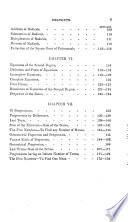 | Charles Davies - Algebra - 1839 - 272 pages
...fourth form both the roots are positive. 2nd. That the first root is greater than the second. 3rd. That the sum of the roots is equal to the coefficient of x in the second term, taken with a contrary sign. 4th. That the product of the roots is equal to the... | |
 | Charles Davies - Algebra - 1842 - 284 pages
...the other negative. 2nd. That the positive root is numerically greater than the negative. 3rd. That the sum of the roots is equal to the coefficient of x in the second term, taken with a contrary sign. 4th. That the product of the roots is equal to the... | |
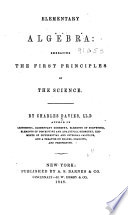 | Charles Davies - Algebra - 1848 - 302 pages
...fourth form both the roots are positive. 2nd. That the first root is greater than, the second. 3rd. 77m/ the sum of the roots is equal to the coefficient of X in the second term, taken with a contrary sign. 4th. That the product of the roots is equal to the... | |
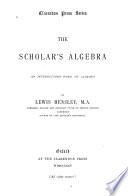 | Lewis Hensley - Algebra - 1875 - 274 pages
...2<Z v I za l> a' by addition, and whence we learn that, if the expression be written in form (ii), I. The sum of the roots is equal to the coefficient...changed ; II. The product of the roots is equal to the last term. This term, which is independent of x, is often called the absolute term. Again, (xd)(xp)... | |
 | Moffatt and Paige - 1879 - 506 pages
...this equation are — ~ and — Adding these values we have — Sum of the Boots = — p. That is, the sum of the roots is equal to the coefficient of x tn the general equation, with its sign changed. Again, multiplying the two values of x, we have —... | |
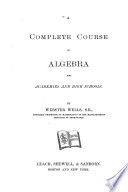 | Webster Wells - Algebra - 1885 - 370 pages
...95) = ^q = _ 4 4 That is, ?/ a quadratic equation be reduced to the form я?+px = q, the algebraic sum of the roots is equal to the coefficient of x with its sign changed, and the product of the roots is equal to the second member, with its sign changed. Example. Required... | |
 | Webster Wells - Algebra - 1885 - 324 pages
...(Art.9ô) =^ = -ç. That is, if a quadratic equation be reduced to the form я?+px = q, the algebraic sum of the roots is equal to the coefficient of x with its sign changed, and the product of the roots is equal to the second member, with its sign changed. Example. Required... | |
 | Webster Wells - 1885 - 368 pages
...(Art. 95) =:z . 4 4 That is, if a quadratic equation be reduced to the form x?+px = q, the algebraic sum of the roots is equal to the coefficient of x with its sign changed, and the product of the roots is equal to the second member, with its sign changed. Example. Required... | |
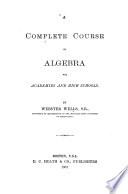 | Webster Wells - Algebra - 1885 - 372 pages
...together, That is, г/ a quadratic equation be reduced to the form a? -\-px = q, the algebraic »urn of the roots is equal to the coefficient of x with its sign changed, and the product of the roots is equal to the second member, with its sign changed. Example. Required... | |
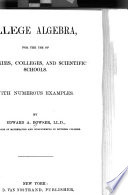 | Edward Albert Bowser - Algebra - 1888 - 868 pages
...quadratic equation where the coefficient of a? is unity and all the terms are in the first member, the sum of the roots is equal to the coefficient of x with its sign changed, and the product of the roots is equal to the third term. Thus, dividing the general equation by a,... | |
| |